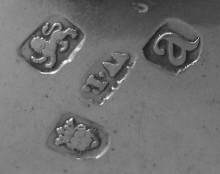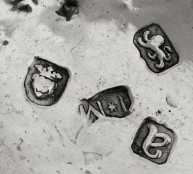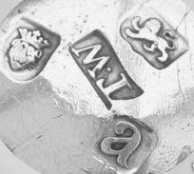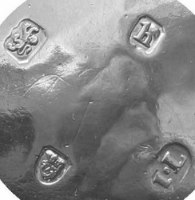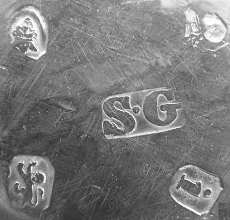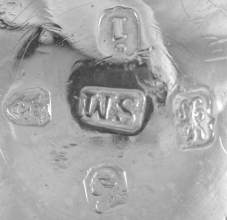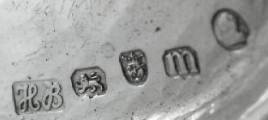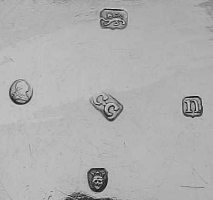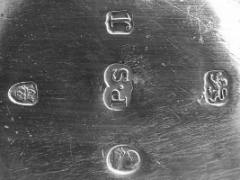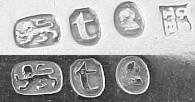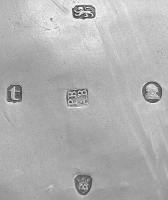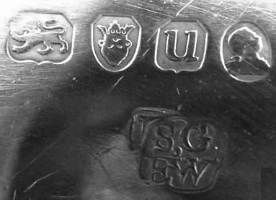by Giovanni
Ciceri
(click on photos to enlarge image)
INTRODUCTION
This is the first of a series of articles dealing with
British hallmarks. Each article will be focused on a
specific cycle of British hallmarks, not taken in a
chronological order, beginning from the London Assay Office.
At the London Assay Office, each series refers to 20 years,
starting with the date letter "a" and ending with the date
letter "u" or "v". Only twenty letters of the alphabet have
been used, excluding: j, v (or u), w, x, y and z. Note that
the last letter of each cycle can be an "u" or a "v", but
this is probably due to the fact that in the classic Latin
language and alphabet there was no difference between "u"
and "v". There is only an exception in the 18th century,
prior the introduction of the Britannia standard (1696) (note
1 ), when the cycle lasted 19 years and ended with
the letter "t". Also the next cycle (from 1697 onward)
lasted 19 years, but in this case all the 20 date letters
have been used.
Each article will present real hallmarks stuck on wrought
silver plate of the current standard (sterling, 925/1000
and/or Britannia, 958.4/1000).
Although the procedure followed from time to time on
hallmarking the silver objects is not the scope of these
articles, I will present and comment, for the same date
letter, different examples of actual hallmarks as found on
various items.
Details on the British hallmarking system, including the
meaning of each hallmark struck on wrought plate are
available at
http://www.argentinglesi.com/marchi-garanziaing.php
while facsimile of British hallmarks can be found at
http://www.silvercollection.it/englishsilverhallmarks.html
BRITISH HALLMARKS - A CYCLE AT A TIME (I)
LONDON HALLMARKS: 1776-1795 (XVI CYCLE)
In the following tables are presented several examples
of the XVI cycle of London Hallmarks. This cycle begins with
a small Roman "a" as date letter for 1776/1777 and ends with
a small Roman "u" for 1795/1796
(note 2).
The punch enclosing the date letter is a shield with a
pointed base with chamfered upper corners (clipped off), but
occasionally it can be found with a rounded base. According
to Jackson, date letters "f" and "k" are usually found in a
shield with pointed base, date letters "g", and "h" are
present in a shield with rounded base; date letter "i" has
been found only in a rounded base shield, while all the
other date letters are contained only in a pointed base
shield. The examples reported below show many examples of
date letters found in both variants of the shield.
Furthermore, it seems that the round base shield was
preferably struck when the leopard head mark was omitted.
This practise is documented since the last years of the 18th
century until about 1810. During this period the London town
marks (the crowned leopard head) was often omitted on small
items like teaspoons, condiment spoons, sugar tongs, etc.,
probably to contrast the practice of duty dodging (see David
McKinley article
The Background To "Duty Dodgers"). The leopard head is
usually omitted on detachable parts of some items like tea
pots, coffee pots and little baskets belonging to epergnes.
Since 1810, to contrast the practice of duty dodging,
hallmarks on flatware were usually struck at the top of the
stem (apart for decorated patterns), with the lion passant
put at 90° with respect to the other marks.
Jackson reports that the lion passant is enclosed in a punch
similar to that of the date letter, with the upper corners
rounded or clipped off. Actually, in some of the examples
illustrated below the lion passant is enclosed in an oval
stamp. Examining these examples, the conclusion is that,
possibly, the oval stamp was preferably used when the
leopard head mark was omitted.
The leopard head is enclosed in a plain oblong punch with
rounded base and upper corners clipped off. Jackson reports
the 1776 mark exception, where the corners are not
chamfered. From the reported examples this assumption is not
completely evident.
At this time the lion passant is "guardant" and the leopard
head is crowned.
This cycle is characterised by the introduction of the duty
mark on 1 December, 1784 (it will remain in use until 30
April, 1890). The mark (the head of the reigning sovereign
in profile as it appeared on contemporary coins) was struck
on gold and silver plate items assayed in England and
Scotland (note 3
, with the exception of a limited number of small articles.
From 1 December, 1784, until 28 May, 1786, the head
of George III was not in cameo, as it afterwards was, but in
intaglio (the die sinker had engraved the punch as the mark
was required to appear in the silver). When the punch was
struck on the silver piece the sovereign profile appeared
sunk and reversed. The head, incuse, looking to the left
appears with the date-letter "i" for 1784/5 and "k" for
1785/6, after which it is always in cameo (looking to the
right until the reign of Queen Victoria) as on the coins of
the period. The intaglio head is in an oblong stamp with the
corners clipped off, but from 1786 the stamp was oval. As
the duty mark was not struck before 1 December, 1784, and
the date letters were changed on 29 May of that year, until
this date the letter "i" was struck without the duty mark
and afterwards was accompanied with the duty mark. A duty
draw-back mark (the incuse standing figure of the Britannia)
was used between 2 December 1784 and 24 July 1785 on
exported piece - allowing the maker to "draw back" the duty
paid. The duty drawback mark is very rare to find.
The introductory page of this article, dealing with
"Determining the date on London Assay Office Marks -
1776-1795" was published in December 2010 Newsletter
click here
|
| London 1776/1777
|
| London 1777/1778
|
London 1778/1779


|
|
John Schofield (left) - Richard
Carter, Daniel Smith and Robert Sharpe
(right)
Grouped hallmarks with the rounded base variant
punch enclosing the date letter
|
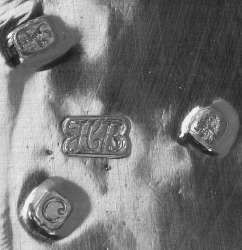
|
|
Hester Bateman
Hallmarks struck in circle as can be found
underneath a cup or mug, with the pointed base
variant punch enclosing the date letter
|
|
London 1779/1780

|
|
Stephen Adams I
"Stressed hallmarks" on stem marked spoons
|
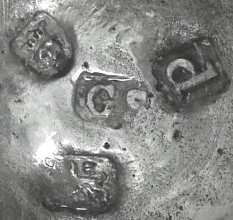
|
|
George Smith II
Hallmarks struck in circle as can be found
underneath a cast pedestal base of a caster. The
limited space available to stuck the hallmarks
around the maker mark and the rough finish of
the piece often makes difficult to read the
hallmarks
|
|
London 1780/1781

|
|
Charles Aldridge & Henry Green
Grouped hallmarks. The date letter seems to have
the rounded base variant punch
|
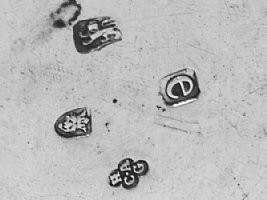
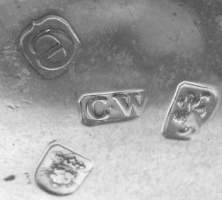
|
|
Charles Aldridge & Henry Green (left)
- Charles Wright (right)
Hallmarks randomly struck in circle. Note that,
in the example on the left, the maker mark has
not a central position
|
|
London 1781/1782


|
|
Benjamin Mordecai (left) - Hester Bateman
(right)
Grouped hallmarks with the rounded base variant
punch enclosing the date letter and the oval
punch enclosing the lion passant.
|


|
|
Robert Hennell (left) - Robert Innes (right)
Grouped hallmarks with the pointed base variant
punch enclosing the date letter
|

|
|
Hester Bateman
Grouped hallmarks on a tea spoon stem. The
leopard head is deliberately missing (to
contrast duty dodging). For many of these
examples, the date letter and the lion passant
are present in the rounded base oval punch
variants respectively
|

|
|
Thomas Shepherd
An unusual example of grouped hallmarks randomly
struck. The date letter is in the pointed base
punch
|
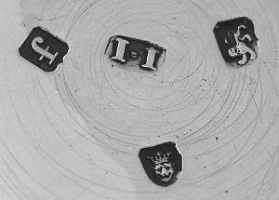
|
|
Joshua Jackson
Hallmarks randomly struck in circle with the
date letter in the pointed base punch
|
|
London 1782/1783

|
|
Elizabeth Jones
Grouped hallmarks with the pointed base variant
punch enclosing the date letter
|

|
|
Hester Bateman
Grouped hallmarks with the rounded base variant
punch enclosing the date letter
|

|
|
Thomas Liddiard
Grouped hallmarks on a tea spoon stem. The
leopard head is deliberately missing (to
contrast duty dodging). For many of these
examples, the date letter and the lion passant
are present in the rounded base and in the oval
punch variants respectively
|
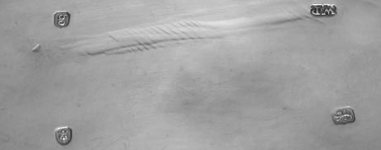
|
|
William Plummer
Typical hallmarking underneath a drum (oval at
this period) teapot. Hallmarks are struck with
small punches at the corner of a rectangle and
not around the maker mark. It is also evident
the sign left by the scraping for assaying the
silver
|
|
| London 1783/1784
|
| London 1784/1785
|
London 1785/1786


|
|
Stephen Adams II (left) - Hester Bateman
(right)
Grouped hallmarks with the rounded base variant
punch enclosing the date letter. The duty mark
is struck randomly, either at the right or at
the left of the other hallmarks and often not
aligned with them.
|

|
|
Thomas Chawner
Grouped hallmarks with the pointed base variant
punch enclosing the date letter
|


|
|
James Perry or James Plumpton or James
Peacock (left) - Thomas Northcote (right)
Grouped hallmarks on a tea spoon stem. The
leopard head is deliberately missing (to
contrast duty dodging). For many of these
example, the date letter and the lion passant
are present in the rounded base and in the oval
punch variants respectively
|
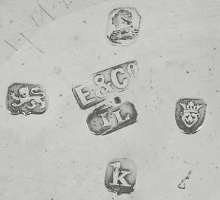
|
|
John Lee II (with a later stamp of a
retailer?)
Hallmarks struck in circle, with the pointed
base variant punch enclosing the date letter, as
can be found underneath a loving cup or a
caster. Note the central position of the maker
mark and the additional marks probably struck
later
|
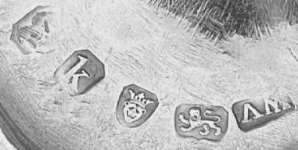
|
|
William Vincent
Typical hallmarking underneath the pedestal base
of a sugar basket
|
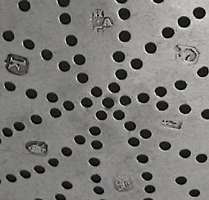
|
|
Charles Aldridge & Henry Green
Rare example of a fully hallmarked item (a lemon
strainer). There are six hallmarks struck in
circle, including the duty draw-back mark (the
incuse standing figure of the Britannia) which
was in use between 2 December 1784 and 24 July
1785 on exported pieces
|
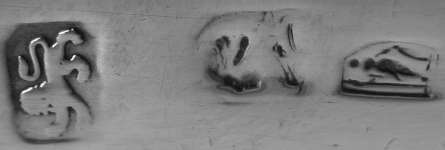
|
|
Hester Bateman (not shown)(from
http://www.silversugartongs.com/)
Duty draw-back mark struck on sugar tongs
|
|
London 1786/1787



|
|
Richard Crossley (top) - George Smith (III)
& William Fearn (middle) - Hester Bateman
(bottom)
Grouped hallmarks. The duty mark is now in cameo
and represents the head of the reigning
sovereign in profile, as it appears on
contemporary coins. Contrary to the incuse duty
marks, the cameo is usually struck on the right
side of the hallmarking series (with the
exception of the maker mark) and is aligned with
the other marks. Note that, in all the reported
examples, hallmarks are struck either on the
left or on the right of the maker mark, but with
the same sequence (lion passant, leopard head,
date letter and duty mark). The sequence differs
from that found on items hallmarked before this
date
|
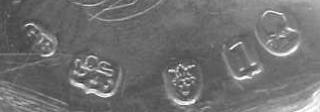
|
|
George Brasier
Typical hallmarking underneath the pedestal base
of a sugar basket
|
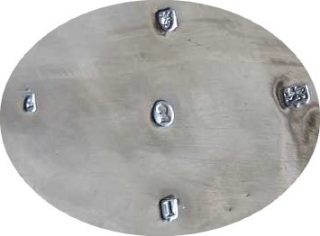
|
|
John Robbins
Hallmarks struck in circle underneath a drum
teapot. Hallmarks (including the maker mark) are
struck with small punches around the duty mark
|
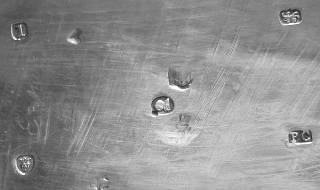
|
|
Peter Carter
Another example of hallmarks struck with small
punches at the corner of a rectangle around the
duty mark underneath a drum tea caddy.
|
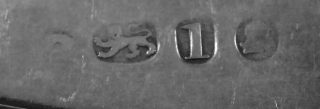
|
|
Maker indistinct
The Leopard head is omitted on a tea spoon. The date letter and the lion passant are
present in the rounded base and in the oval punch variants respectively.
|
|
| London 1787/1788
|
| London 1788/1789
|
London 1789/1790





|
|
Hester Bateman (top row, left) - George Gray
(overstruck on Hester Bateman) (top row, right)
Joseph Scammel (middle row, left) - William
Pitts (middle row, right)
William Stroud (bottom row)
Grouped hallmarks with the pointed base variant
punch enclosing the date letter. Note that, in
all the reported examples, hallmarks are struck
either on the left or on the right of the maker
mark, but with the same sequence (lion passant,
leopard head, date letter and duty mark)
|

|
|
George Smith III & William Fearn
Grouped hallmarks on a tea spoon stem. The
leopard head is deliberately missing. For many
of these examples, the date letter and the lion
passant are present in the rounded base and in
the oval punch variants respectively
|
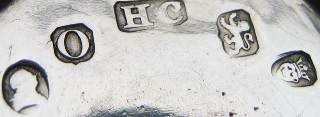
|
|
Henry Chawner
Unusual hallmarking underneath the pedestal base
of a sugar basket. Hallmarks are struck part on
the right and part on the left of the maker mark
and not in the usual sequence. Note the pointed
base variant punch enclosing the date letter
|
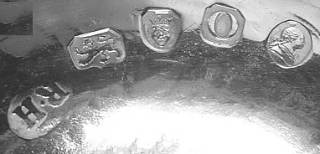
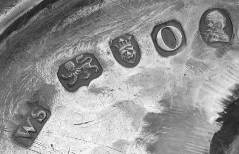
|
|
Robert Hennel (left) - William Stroud
(right)
Typical hallmarking underneath the pedestal base
of a sugar basket. Note the rounded base variant
punch enclosing the date letter
|
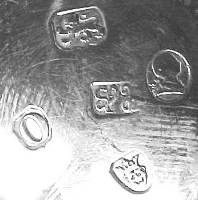
|
|
George Gray (overstruck on Hester Bateman)
Hallmarks struck in circle, with the pointed
base variant punch enclosing the date letter, as
can be found underneath an open salt cellar.
Note the central position of the maker mark
|
|
London 1790/1791




|
|
Elizabeth Jones (top row, left) - George
Gray (top row, right)
Peter & Jonathan Bateman (bottom row, left) -
Thomas Wallis II (bottom row, right)
Grouped hallmarks with the pointed base variant
punch enclosing the date letter. Note that, in
all the reported examples, hallmarks are struck
either on the left or on the right of the maker
mark, but with the same sequence (lion passant,
leopard head, date letter and duty mark)
|


|
|
Hester Bateman (left) - (maker mark missing)
(right)
Grouped hallmarks on a tea spoon stem. The
leopard head is deliberately missing. For many
of these examples, the date letter and the lion
passant are present in the rounded base and in
the oval punch variants respectively
|
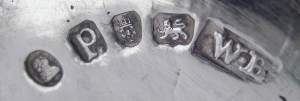
|
|
Walter Brind
Typical hallmarking underneath the pedestal base
of a sugar basket. Note the pointed base variant
punch enclosing the date letter and the unusual
sequence of the other hallmarks
|
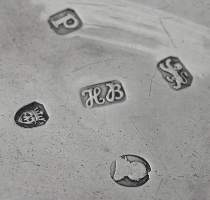
|
|
Hester Bateman
Hallmarks struck in circle, with the pointed
base variant punch enclosing the date letter as
can be found underneath an open salt cellar.
Note the central position of the maker mark
|
|
London 1791/1792


|
|
George Smith (left) - Henry Chawner (right)
Grouped hallmarks with the pointed base variant
punch enclosing the date letter. Note that, in
all the reported examples, hallmarks are struck
either on the left or on the right of the maker
mark, but with the same sequence (lion passant,
leopard head, date letter and duty mark)
|

|
|
George Smith III & William Fearn
Grouped hallmarks on a tea spoon stem. The
leopard head is deliberately missing. For many
of these examples, the date letter and the lion
passant are present in the rounded base and in
the oval punch variants respectively
|
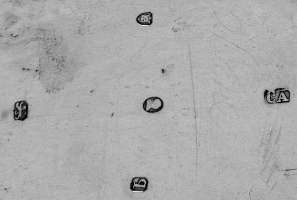
|
|
Charles Aldridge
Hallmarks struck around the duty mark underneath
a drum tea pot
|
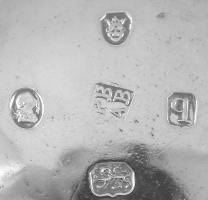
|
|
Peter & Anne Bateman
Hallmarks struck in circle, with the pointed
base variant punch enclosing the date letter, as
can be found underneath an open salt cellar.
Note the central position of the maker mark
|
|
| London 1792/1793
|
London 1793/1794

|
|
John Wakelin & Robert Garrard
Grouped hallmarks with the rounded base variant
punch enclosing the date letter
|

|
|
John Mewburn
Grouped hallmarks with the pointed base variant
punch enclosing the date letter
|

|
|
John Blake ?
Grouped hallmarks on a salt spoon stem (duty
marks partially rubbed). The leopard head is
deliberately missing. For many of these
examples, the date letter and the lion passant
are present in the rounded base and in the oval
punch variants respectively
|
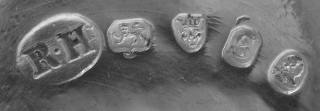
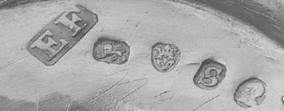
|
|
Robert Hennell (left) - Edward Fernel
(right)
Typical hallmarking underneath the pedestal base
of a sugar basket or a neo-classic coffee pot
(urn shaped). Note the rounded base variant
punch enclosing the date letter
|
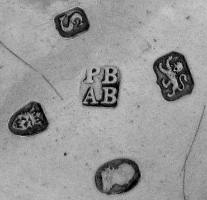
|
|
Peter & Anne Bateman
Hallmarks struck in circle, with the pointed
base variant punch enclosing the date letter
|
|
| London 1794/1795
|
| London 1795/1796
|
ENDNOTE
1 - The current silver standard for silverware was the sterling
standard (925/1000) since 1300. Between 1696 and 1720 the
Britannia standard (958.4/1000) was compulsory. After 1720
sterling standard was re-introduced, but the Britannia standard
was not abolished and left as optional. However, after 1720 a
very few number of items have been made in Britannia standard.
For more details see the article
"Britannia" silver standard hallmarks in Great Britain
2 - The date letter changed on May of each year, usually in
occasion of the Goldsmiths' Patron day (St. Dunstan, May 19),
when the wardens were elected. So, each date letter usually
refers to two years, but it is common prectice to refer the date
letter to the first year only. There is only an exception to
this rule: after the introduction of the Britannia Standard in
1697, the court letter "a" was used only from 27 May to 29 May
of that year.
REFERENCES
Charles J. Jackson, 1964. English Goldsmiths and their marks
- A history of the goldsmiths and plate workers of England,
Scotland and Ireland. Second Edition, revised. Dover
Publications Inc., New York.
Arthur G. Grimwade, 1976. London goldsmiths 1697-1837: Their
marks and lives - from the original registers at Goldsmiths'
Hall and other sources.
John Culme, 1986. The Directory of Gold & Silversmiths
Jewellers & Allied Traders 1838-1914, voll. I e II - Antique
Collectors Club. Woodbridge, Suffolk (UK)
Ian Pickford Silver Flatware, 1983. English, Irish & Scottish
1660-1980. Antique Collectors' Club, Woodbridge, Suffolk (UK)
|
|
|
|
 ASSOCIATION OF SMALL COLLECTORS OF ANTIQUE SILVER
ASSOCIATION OF SMALL COLLECTORS OF ANTIQUE SILVER


